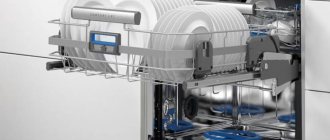Buying and using a dishwasher for the first time is an exciting experience. Great expectations are placed on household appliances. It is she who should save the housewife from unpleasant everyday work. However, before starting active operation, it is necessary to test the unit. Don't know how to do this?
We will help you prepare your dishwasher for use. The article describes in detail the process of idle start-up, outlines the rules for putting the unit into operation, and also provides tips on choosing the appropriate washing program and servicing the equipment.
Dishwasher testing
When a long-awaited device appears in the house, the owner wants to immediately turn it on and check its functionality.
There's no need to rush. First, you should carefully read the instructions so that standard operation of the equipment does not appear to be signs of breakdown.
The operation of dishwashers from different manufacturers can vary significantly, so appliance manufacturers provide detailed instructions for the first start-up. Do not ignore their recommendations, otherwise you may encounter unexpected problems during operation of the device.
Purpose of checking the dishwasher
Before switching on for the first time, it is mandatory to test the dishwasher - run one cycle without loading dishes.
This check has several purposes:
- Cleaning. After manufacturing at the factory, traces of lubricants and small particles of debris remain inside the parts of new equipment. While the car is in the store, it is inspected and touched with hands, which leads to the appearance of stains. A test run removes dirt and prepares the equipment for use.
- Functionality check. During the first switching on, defects in the manufacturing of the equipment appear. If it was damaged during transportation, this will also become obvious.
- Monitoring correct installation and connection. There is always a place for unfortunate accidents in life. The installers could have made a mistake during installation, connection to the water supply or sewerage system. Sometimes they simply forget to remove the shipping elements. The test will reveal any shortcomings.
- User training. Even if this is not your first dishwasher, you still have to get used to the new equipment. Machines from different manufacturers have their own characteristics, and you need to deal with them before the device is put into operation.
For a test run, you will need a starter kit - detergent, salt and rinse aid. It is either purchased separately specifically for testing the machine, or the one that is planned to be used for washing dishes in the future is used. This will help you decide on the amount of salt and type of detergent.
Sometimes users make the mistake of running the first cycle without detergent, loading only salt. In this way they are trying to save an extra tablet or dose of gel. Do not do this. Hot water will wash away the technical lubricant, but traces of the greasy composition may remain under the rubber bands.
Procedure for idle start
First of all, the dishwasher is carefully inspected. You need to make sure that it is not damaged and that there are no foreign objects in the camera. Sometimes foam sealing inserts, stickers, etc. are forgotten inside the device. If everything is in order, you can turn on the machine and unscrew the valve that shuts off the water.
Then they proceed according to the following scheme:
- Check whether the machine is level.
- All supply and outlet hoses must be securely connected and joints sealed. Make sure of this.
- Open the camera door. You need to check whether the sprayer rotates freely. To do this you need to turn it several times.
- The drain filter is unscrewed, thoroughly washed with running water and household chemicals, and then replaced.
- When selecting detergents, you need to find ones that will not damage machine parts. The required amount of salt and rinse aid is calculated immediately in order to set a program for the future.
- When all the preparatory work is completed, the machine is set to the longest dishwashing mode without loading the basket. It is important that the temperature is as high as possible.
- All that remains is to close the door tightly, start the dishwasher and monitor its operation. If everything is going well, there is no need to interfere and try to improve something.
To prevent the regenerating salt from sticking together while the machine is running, pour about a liter of clean water into the empty compartment.
What to pay attention to when starting for the first time?
During operation of the dishwasher, the determining parameters for the correct installation and serviceability of the equipment are:
- uninterrupted water supply. The dishwasher should not stop or switch to pause mode. If problems arise, it is worth checking the correctness of the water connection, the intensity of pressure in the supply hose;
- uniform heating. The heating element should normally heat the water to sufficiently high temperatures, and the sensors should display information on the control panel. Unfortunately, when purchasing in a store, it is impossible to check the operation of the heating element, which is why it is so important to run the machine for the first time in test mode;
- draining water - there should be no liquid left in the compartment for dishes; water is normally discharged into the sewer in full;
- drying. After completing the test cycle, there should be no condensation or droplets of moisture left inside the dishwasher. Otherwise, the drying was insufficient, there may be a problem or a program failure.
If no problems were found during the diagnostic process, and the PMM successfully passed the test, you can safely install it in a prepared place and use it for its intended purpose. Some time should pass between the first start and washing the dishes: you need to let the equipment cool down. Next, be sure to familiarize yourself with how to properly load your dishwasher.
Getting started - first operational start
This stage is started only after a test run of the PMM in idle mode. Otherwise, even if everything is in order with the equipment, traces of industrial grease may remain on clean dishes. These substances are potentially dangerous. It’s better not to save money and risk your health.
Before starting operation, you will have to spend a little time and deal with pressing issues. You need to take care of selecting detergents, preparations for preventive maintenance, learn how to load the basket correctly, and find the optimal program for your existing cutlery.
We offer step-by-step instructions for preparing to turn on the dishwasher for the first time in operating mode.
Step 1: selection of household chemicals
To keep your dishes consistently clean, you need to decide on the best products for your particular machine model.
You should focus on the following criteria:
- Release form. There are powder, tablet, and gel formulations. The quality of dishwashing and the cost-effectiveness of product consumption depend on the choice.
- Compound. Complex chemical preparations may contain several active ingredients. Each performs its own function and copes best with a certain type of task. You should choose depending on the type of cookware.
- Safety. Harsh chemicals can be harmful to health. It is better not to use certain brands of products if there are children, old people, pregnant women, allergy sufferers, and asthmatics in the house.
- Price. A dishwasher saves the housewife time and effort, but this does not mean that you should go broke. You need to decide on the budget that will be allocated monthly for household chemicals and select formulations that are suitable for the price.
In addition to detergents, you will also need compounds for water softening, manual and automatic cleaning of the dishwasher, removing scale from the walls of the chamber, heating element and other machine parts.
Electrolux household appliances are famous for their quality and wide variety of models. In order for it to serve properly and for a long time, it is important to follow the recommendations from the instructions for the Electrolux dishwasher. The most important information from this user manual is included in our article, and it will help you save time reading a long list of obvious things, providing only what is most relevant to the user.
Preparing for the first use
After removing the packaging from the machine, inspect it thoroughly. If you have any complaints about the condition of the unit, it is better to immediately call a service specialist. If everything is in order with the dishwasher, you need to check the package, remove the protective clips and proceed with installation.
After installing the device, most consumers have an irresistible desire to turn on the dishwasher and evaluate the results of its operation. Many manufacturers such as Asko, Whirlpool, Electrolux strongly recommend a mandatory test run.
A test run is also an opportunity to ensure that the device is installed correctly:
- The structure must be located on a hard, level surface. Even a slight deviation from the horizontal level can lead to malfunctions and additional noise and vibration.
- It is not recommended to install a dishwasher under a kitchen hob. It will generate excess heat, and its magnetic radiation may cause incorrect operation.
- It is necessary to make sure that the electrical outlet is in working order; the connecting wire of the machine should not heat up when it is turned on. It is advisable not to use extension cords when connecting to AC power.
- Make sure that the cold water supply valve is working properly; it should completely shut off the water. This is necessary for prompt shutdown in case of leakage.
- It is necessary to check the water supply hose itself; if possible, then install an additional filter.
- When connecting the device to the sewer, it is important to make sure that the drain hose is not bent or pinched. It is necessary to fix it well in the corresponding hole in the machine.
- When closing the dishwasher door, you should hear a characteristic clicking sound. The impeller should rotate evenly and smoothly.
Safety precautions and rules for loading the Electrolux dishwasher
In order for the Electrolux dishwasher to serve for a long time, it is important to follow the recommendations from the operating instructions. First of all, you need to correctly load the trays and baskets of the unit for its operation to be effective. To do this, you need to place the plates vertically on the bottom shelf and place knives, forks and spoons in a special tray there.
Cups, bowls and pots are placed on the second shelf upside down. Folding holders are provided for glasses and glasses. If you place dishes differently, they may not be washed as well.
When operating an Electrolux dishwasher, you should follow several safety rules:
- do not open the door without first stopping the program, so as not to be scalded by splashes of hot water;
- keep detergents away from children;
- place knives with the tip down when loading the tray vertically;
- turn off the water every time after use;
- Connect the device only to a grounded outlet.
At the same time, the instructions for the Electrolux dishwasher clearly state what items are prohibited from being placed inside: pots and pans with wooden handles, copper utensils, aluminum utensils, antique porcelain, plastic bowls and cups, fine crystal items.
Detergents and additives
High cleaning efficiency can only be ensured by using suitable detergents. At the same time, manufacturers pay a lot of attention to their choice. Special salt and detergents allow you to wash even the most severe stains.
For the rinsing procedure, a special container is installed in the equipment.
At the same time, in the document you can find a detailed description of the design, precautions for filling and other points. A separate section is devoted to the classification of all used detergents, how they are properly used and transported.
Instructions for adding cleaning products
All Electrolux dishwashers have a similar structure, which makes it easier to follow the instructions for adding cleaning products. First, you should add special salt, which will soften the water and provide better cleaning.
In Electrolux household appliances, the compartment for the substance is located on the left in the near corner. Unscrew the neck cap and add dishwasher salt. Table salt should not be added, as this will lead to damage to the internal elements. You can add the product only before the next start of washing, otherwise the crystals that have fallen into the pan will cause corrosion.
If the dishwasher doesn't turn on
There are many reasons why your dishwasher won't turn on. Many, such as a kinked hose or a clogged filter, can be fixed with your own hands, but others cannot. Most likely, you will have to call a technician, but if the device is new and does not turn on the first time you start it, then you should immediately replace the dishwasher itself or, at least, have it repaired for free under warranty.
That's all. Take care of your “kitchen helper” and use it correctly.
Please rate the article:
Join on Telegram
Selecting an Electrolux dishwasher program
The Electrolux dishwasher manual will also help you understand the control buttons, of which there are six in most models. On the left is always the power key. Then there are four buttons in the center that allow you to select one of the programs. The rightmost key can delay the start from 3 to 9 hours. The panel is completed by a row of light indicators, indicating the stage of washing or the end of the supply of cleaning products in the containers.
Having dealt with the control buttons, you can proceed to selecting a program. Most Electrolux models have four options:
- Intensive. Occurs at 70 degrees and is the longest in time. Suitable for dishes with dried food marks.
- Standard. Performed at 65 degrees and applicable to dirty dishes, but without dried marks.
- Accelerated. Optimal for quickly washing plates and cups after meals, which leaves almost no greasy stains. The program is implemented at a temperature of 65 degrees.
- BIO. Starts the wash at 50 degrees, maximizing water and energy savings. Suitable for normal soiling.
Electrolux dishwasher care
The operating instructions for the Electrolux dishwasher require regular maintenance of the unit. After each use, you need to wipe the gasket around the door. Once a quarter you should run a standard program, but without dishes, which will clean the chamber from the inside. Once every two weeks, you need to unscrew the drain filter and clean it of food debris. The nozzle holes are cleaned with a needle every three months.
The Swedish brand Electrolux has long been in demand among users; the popularity of this company was brought by the Inspire line of washing machines, and now more and more people prefer PMM from this manufacturer. Electrolux dishwashers are modern kitchen assistants that relieve owners from washing dishes by hand.
Features of the device and configuration
The functionality of dishwashers is constantly being improved, which is why models from the Swedish brand are in great demand among consumers. Among the functional features of the dishwasher, several product lines can be noted:
- The “green” series is designed for economical electricity consumption due to simultaneous connection to cold and hot water.
- “Comfort Lift” is a model range of devices with adjustable basket height. The special mechanism makes it easy to use.
- “Real Life” is a line of large-sized machines with large capacity.
- “Real Life Slim” – compact dishwashers up to 45 cm wide.
- FlexiWash is a modern development aimed at various degrees of cleaning and temperature conditions.
Advantages and disadvantages of the company
PMMs from the Swedish brand Electolux demonstrate many advantages over models from other companies:
- economical consumption of “A-class”;
- connection to hot water;
- loading chamber capacity;
- reduced noise level;
- availability of 2 or 3 baskets;
- ease of control
- stylish design.
Judging by the reviews of the owners, the disadvantages of the models of this company are:
- lack of protection from children;
- there is no protection against leaks;
- no half load mode.
Review of manufacturer's models
The devices have several series, which differ in size, capacity, and cost. Below are rating models that gained their popularity thanks to user ratings.
Built-in standard
Full-sized built-in dishwashers from Electrolux have an average width of 60 cm. They are distinguished by their large capacity and the presence of various modes.
Electrolux ESL 9531 LO
The full-size dishwasher is designed for 13 sets, while consuming up to 10 liters of water. The device is equipped with leakage protection, a clean water sensor, and condensation drying. The machine is controlled using 5 programs and 4 temperature modes.
- there is a child lock;
- good capacity;
- there is a connection to hot water;
- low noise level.
- no water hardness adjustment;
- takes a long time to wash.
Electrolux ESL 7310RA
The built-in full-size PMM measuring 59*55*81 cm, despite its compactness, has a large loading chamber. It is designed for 13 sets of dishes. The adjustable basket allows you to load even large pots or large diameter plates. Using the digital display, you can set the desired program, and there are only 6 of them.
- capacity;
- sound insulation;
- low water and electricity consumption;
- There is a “beam on the floor” function.
Cons: none found.
Built-in narrow
Due to its compactness, the built-in narrow dishwasher is in great demand among consumers. This is a great option for a small kitchen or rented apartment.
ESL 94200 LO
This model attracts with its budget price – from 15 thousand rubles. The total volume of sets is 9. The narrow-sized model supports 5 washing programs and 3 temperature settings. There is a hot drying mode. Both the hose and the device body are protected from leaks.











